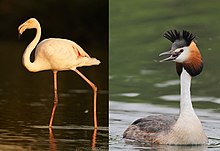Mirandornithes
| Mirandornithes | |
|---|---|

| |
| Greater flamingo (Phoenicopterus roseus) and great crested grebe (Podiceps cristatus) | |
| Scientific classification | |
| Domain: | Eukaryota |
| Kingdom: | Animalia |
| Phylum: | Chordata |
| Class: | Aves |
| Clade: | Neoaves |
| Clade: | Mirandornithes Sangster, 2005 |
| Subclades | |
| |
| Synonyms[3] | |
| |
Mirandornithes
Determining the relationships of both groups has been problematic. Flamingos had been placed with numerous branches within
storks. The grebes had been placed with the loons. However more recent genomic studies have confirmed these two branches as sister groups.[6][7][8][9][10][11][12]
Both primitive phoenicopteriformes and their closest relatives, the grebes, were highly aquatic.[13] This indicates that the entire mirandornithe group evolved from aquatic, probably swimming ancestors.[9]
Etymology
The term was coined by Sangster in 2005, in order to properly describe the new clade discovered with molecular analyses. It is inspired by the latin miranda, meaning "wonderful", and the greek ορνιζ (ornis), meaning bird.[4]
Synapomorphies
According to Mayr (2004) and Sangster (2005) there are at least twelve distinct morphological
synapomorphies that are unique to this clade:[4]
- "At least the fourth to seventh cervical vertebrae strongly elongate, with processus spinosus forming a marked ridge.
- Humerus with a marked oval depression at insertion site of musculus scapulohumeralis cranialis.
- At least 23 presacral vertebrae.
- At least four thoracic vertebrae fused to a notarium.
- Distal end of ulna with marked oval depression radialis.
- Phalanx proximalis digiti majoris very elongate and narrow craniocaudally.
- Distal rim of condylus medialis of tibiotarsus distinctly notched.
- Pars acetabularis of musculus iliotibialis lateralis absent.
- Pars caudalis of musculus caudofemoralis absent.
- Wing with 12 primaries
- Left arteria carotis reduced or absent.
- Eggs covered with a chalky layer of amorphous calcium phosphate."
References
- ^ Švec, P. 1982. Two new species of diving birds from the lower Miocene of Czechoslovakia. Časopis pro mineralogii a geologii, 27, 243–260.
- PMID 32781465.
- .
- ^ .
- PMID 25504713.
- ^ PMID 25504713.
- PMID 11429133.
- PMID 15022765.
- ^ .
- S2CID 1296408.
- PMID 17148284.
- S2CID 6472805.
- ^ Mayr, G. (2014) The Eocene Juncitarsus – its phylogenetic position and significance for the evolution and higher-level affinities of flamingos and grebes. Comptes Rendus Palevol. 13(1):9-18. https://doi.org/10.1016/j.crpv.2013.07.005


